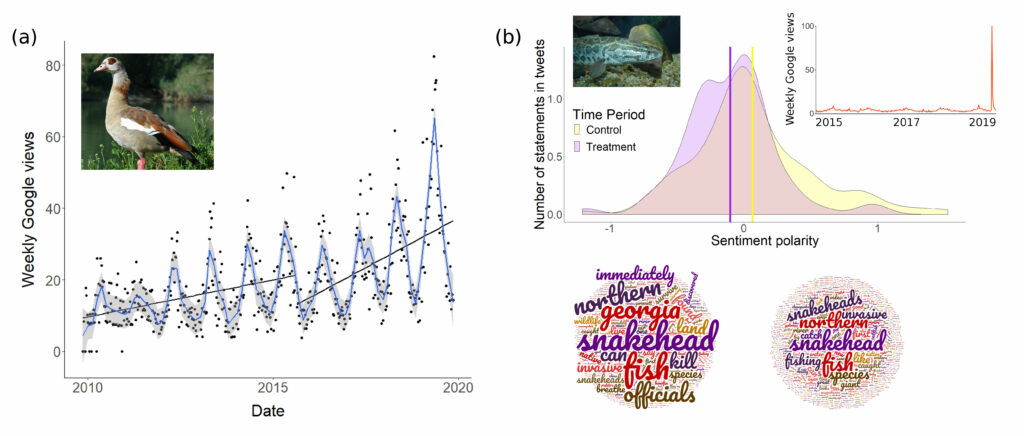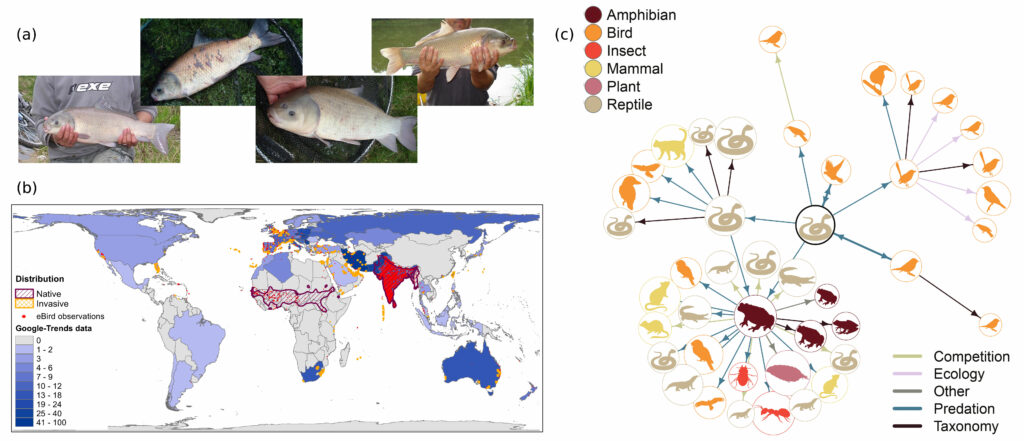The introduction of invasive alien species (IAS) represents a key stage in the invasion process and one where management measures, if applied early enough, are most cost-effective. Improved understanding of socioeconomic and ecological factors that are driving introduction events can improve IAS risk assessments and management effectiveness. However, the data on these early phases of invasion process are often not available, and obtaining them is costly, time-consuming and often impossible. The project focuses on harnessing large digital data sources with approaches from the emerging fields of culturomics and iEcology. Main focus is on species from the list of IAS of Union Concern. By integrating biological, socioeconomic and cultural factors, this project will yield novel insights into the mechanisms influencing the invasion process.

Examples of the culturomics and iEcology data generated by the methods used in the project (Jaric et al. 2021; https://doi.org/10.1111/cobi.13707). (a) Relative search volumes (Google Health-Trends-API) for Egyptian Goose (Alopochen aegyptiaca) in Germany over 10 years (2009 to 2019; structural break in August 2015) and (b) results of a sentiment analysis of tweets on northern snakehead (Channa argus) invasion in the United States posted during the period of high media attention due to new records of species introductions (6-12 October 2019) and during a control period when there was no media attention (January to June 2019) (vertical lines, median values; inset graph, U.S. public interest in northern snakehead from 2014 to 2019 based on Google Trends) and word clouds for the target period (left) and the first 6 months of 2019 (right).
The overall aim of the project is to develop a model that will explain the process of alien species introductions, determined by a combination of societal and ecological factors, through the use of Big Data collated with conservation culturomics and iEcology techniques, and integrated with data extracted from traditional data sources. With this model, we aim to answer the following research questions:
1) To what extent does public awareness, behaviour and attitudes towards IAS affect introduction dynamics?
2) Are particular introduction pathways (e.g., intentional vs. unintentional) linked to specific species traits and driven by a public with specific levels of awareness, behaviour and attitudes towards IAS?
3) Do public awareness, behaviour and attitudes toward alien species change following their introduction?
4) Which species, currently not introduced to the European region, are highly likely to end up so?
A more general research question we want to address is: What information can culturomics and iEcology data provide regarding IAS, introduction events and pathways, and associated societal and ecological factors?

Examples of the culturomics and iEcology data generated by the methods used in the project (Jaric et al. 2021; https://doi.org/10.1111/cobi.13707). (a) Images obtained from angler websites of North American buffalo fishes (Ictiobus sp.) in natural environments in the Czech Republic (Kalous et al. 2018; https://doi.org/10.1051/kmae/2018019), (b) global distribution of Rose-ringed Parakeet (Psittacula krameri) based on relative search volumes (Google Trends), BirdLife and Birds of the World data (purple and yellow areas), and eBird distribution data (red points), and (c) directed network of the second-order linked-out species from the English Wikipedia for the brown tree snake (Boiga irregularis) page (node size, relative to number of views each page received from 1 July 2015 to 28 November 2019; arrows, direction of web links between pages; node, taxonomic group; edge colors major interaction types between species).
To answer these research questions, we will:
I. Gather data on the three main factors that may influence the introduction of alien species (i.e., event-related characteristics, location characteristics, and species traits). These data will be gathered through both traditional and novel approaches (i.e., iEcology and culturomics), with the following specific aims:
Ia. Collect data on event-related characteristics, such as societal factors, introduction pathway type, presence of IAS in the pet and ornamental species trade, and the resulting propagule pressure;
Ib. Collect data on location characteristics, including available habitat and climate, which affect species geographic attributes, such as range size or abundance;
Ic. Collect data on IAS traits, including life history, key morphological characteristics, behavioural traits, diet, functional roles, biotic interactions, range size, and phenology.
II. Identify which combinations of factors can result in the introduction of alien species through data validation and integration (WP4) and data analyses, including an IAS introduction model.
To learn more about the field of conservation culturomics, see:
http://www.conservationculturomics.com
To learn more about the field of iEcology, see:
